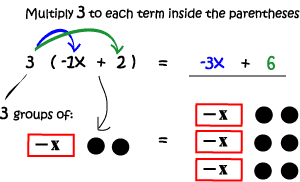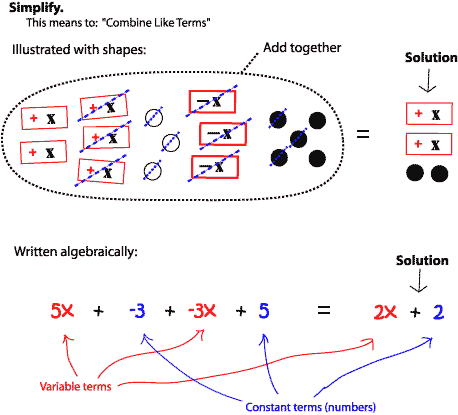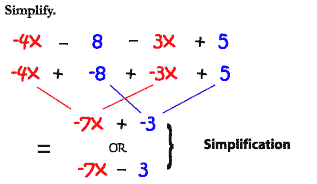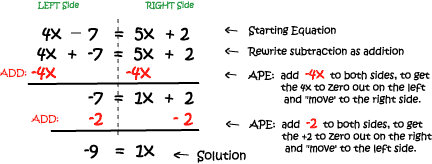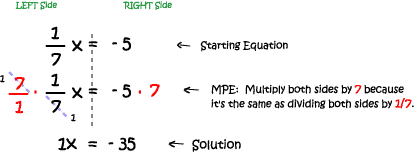| << Back | |||||
|
|
Solving Equations NOTES | ||||
| [Distribution] [Combining Like Terms] [Additive Property of Equations] [Multiplication Property of Equations] | |||||
Another skill that is sometimes used while solving equations is multiplication. Actually, this is the first thing to look for when solving an equation. Multiply the term outside the parentheses to each term inside the parentheses. After any multiplying, the next step is to determine if any combining of like terms will occur. The following example is illustrating the constant term of 3 multiplying to each term inside the parentheses both algebraically and with a model.
When "simplifying an expression"... you combine the "like terms" in the expression. Attention to combining variable terms with other like-variable terms (letters with other like-letters) and constant variable terms with other constant variable terms (numbers with other numbers) is crucial in this skill. Sometimes, in order to "see" the like terms a model (drawing) is helpful. After you are able to visualize the terms you are trying to combine, the model isn't needed for the process. Below, the variable terms are modeled with boxes and the constant terms are modeled with dots.
[Top] The Additive Property of Equations (APE) is useful to "zero out" terms from one side of the equal sign in an equation. The APE ensures that after adding the same term to both sides of the equal sign, the equation remains balanced. To "zero out" a term from one side of the equal sign, the opposite of the term is chosen and added to both sides of the equation. This is why after a term is "zero-ed out" on one side of the equation, it appears as its opposite on the other side of the equation. Example: Solving by adding a variable term to both sides.
Example: Solving by adding a constant term to both sides.
Example: Solving by adding a variable and constant terms to both sides (Use APE twice).
The Multiplication Property of Equations (MPE) is used (if needed) to change the coefficient in front of the variable to be a "+1". If after the APE is used, if the coefficient (the number) is anything other than "1"... the MPE is used. Remember that division of a number is the same thing as multiplying by the number's reciprocal. Again, if any multiplication (or division) is performed to the left side of an equation, the exact operation must be performed to the right side of the equation to keep the balance. Example: Solving by dividing by a constant term to both sides.
Example: Solving by multiplying by the reciprocal of the number in front of the variable to both sides.
Some solving of equations may take a few steps where all four areas mentioned above are addressed: Distribution, Combining Like Terms, APE, and MPE while some equations may require only one area to be addressed to solve the equation. 4 questions to ask yourself while "solving" an equation...
|
|||||
| [Top] | |||||


